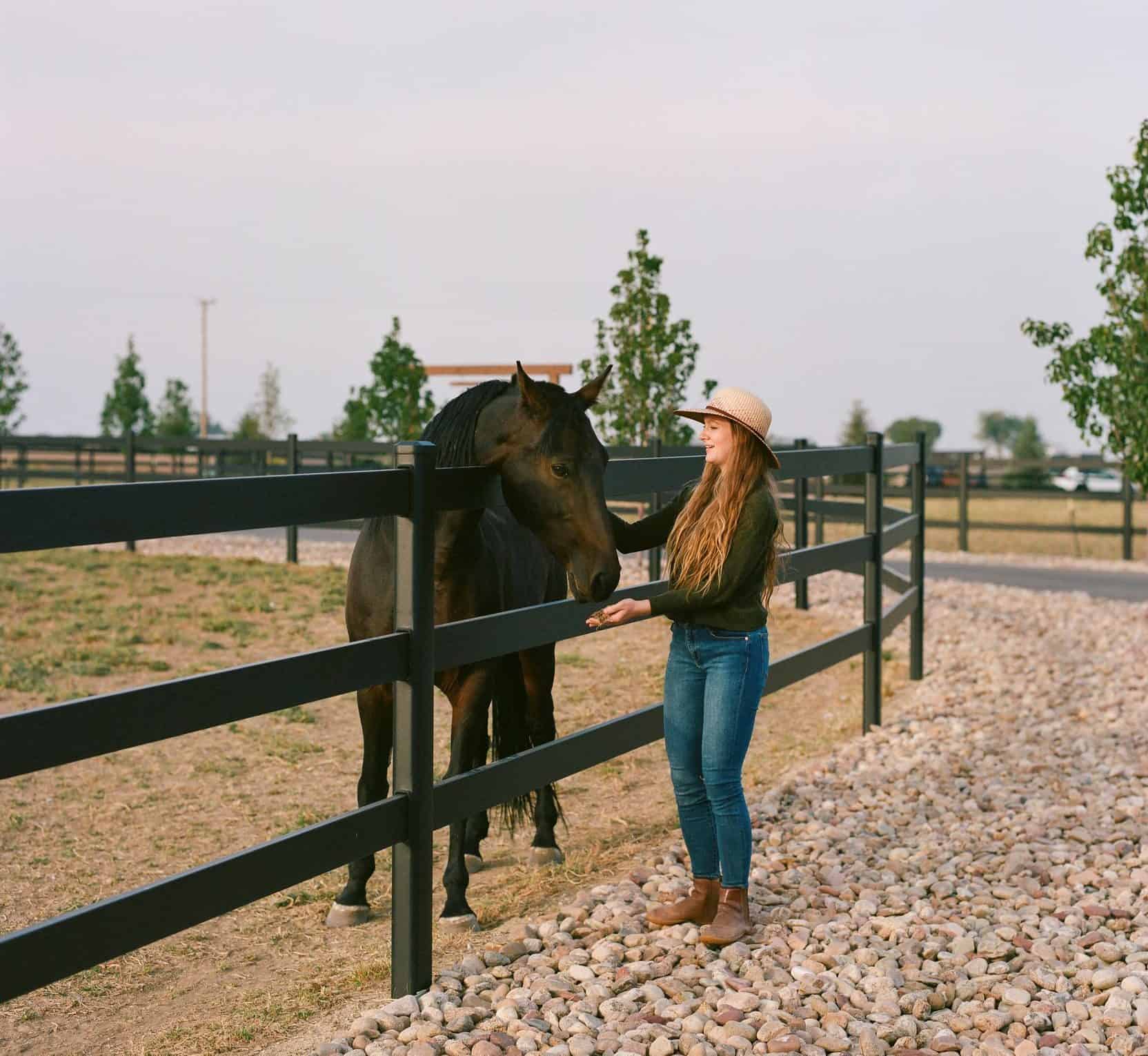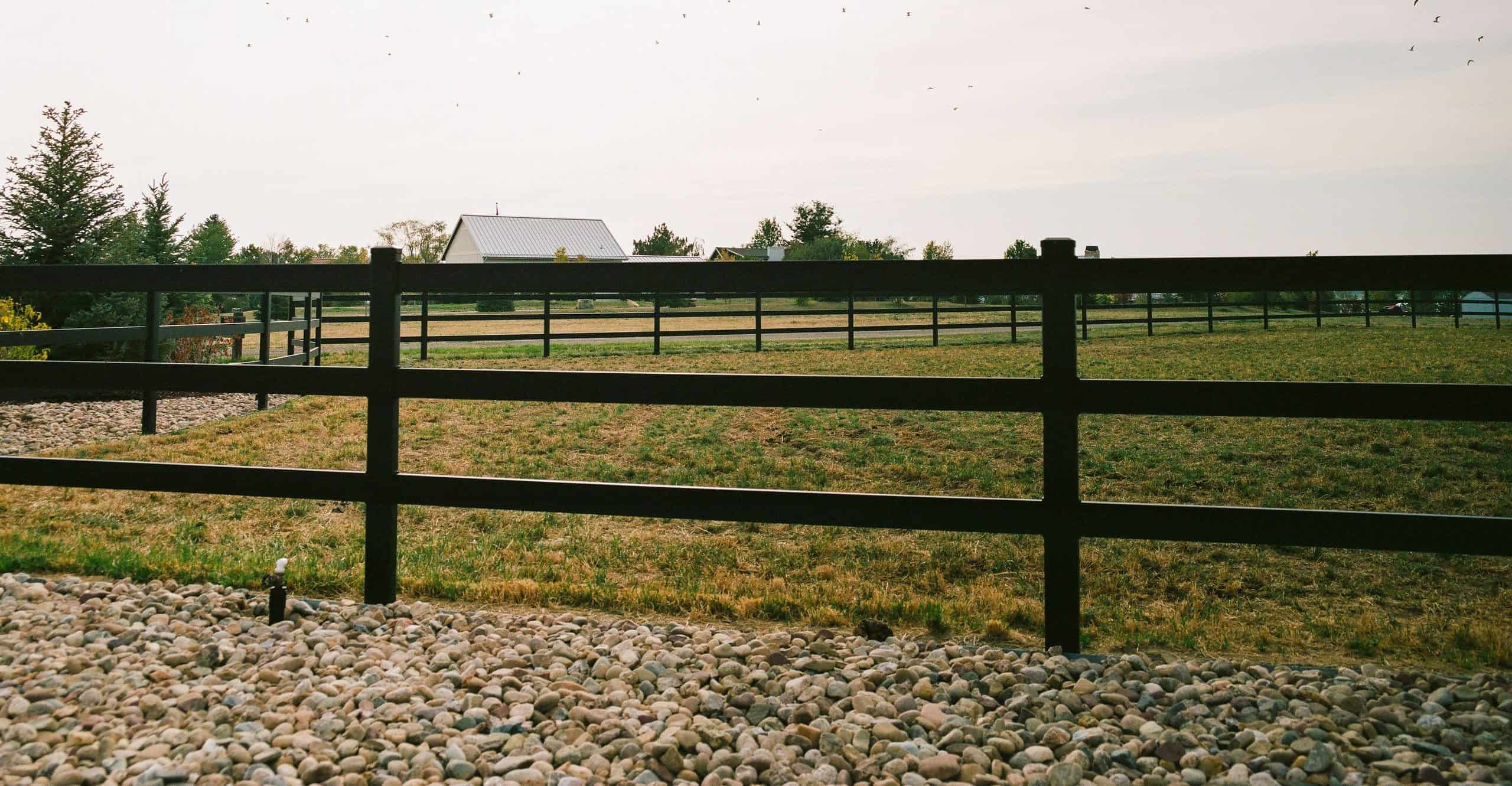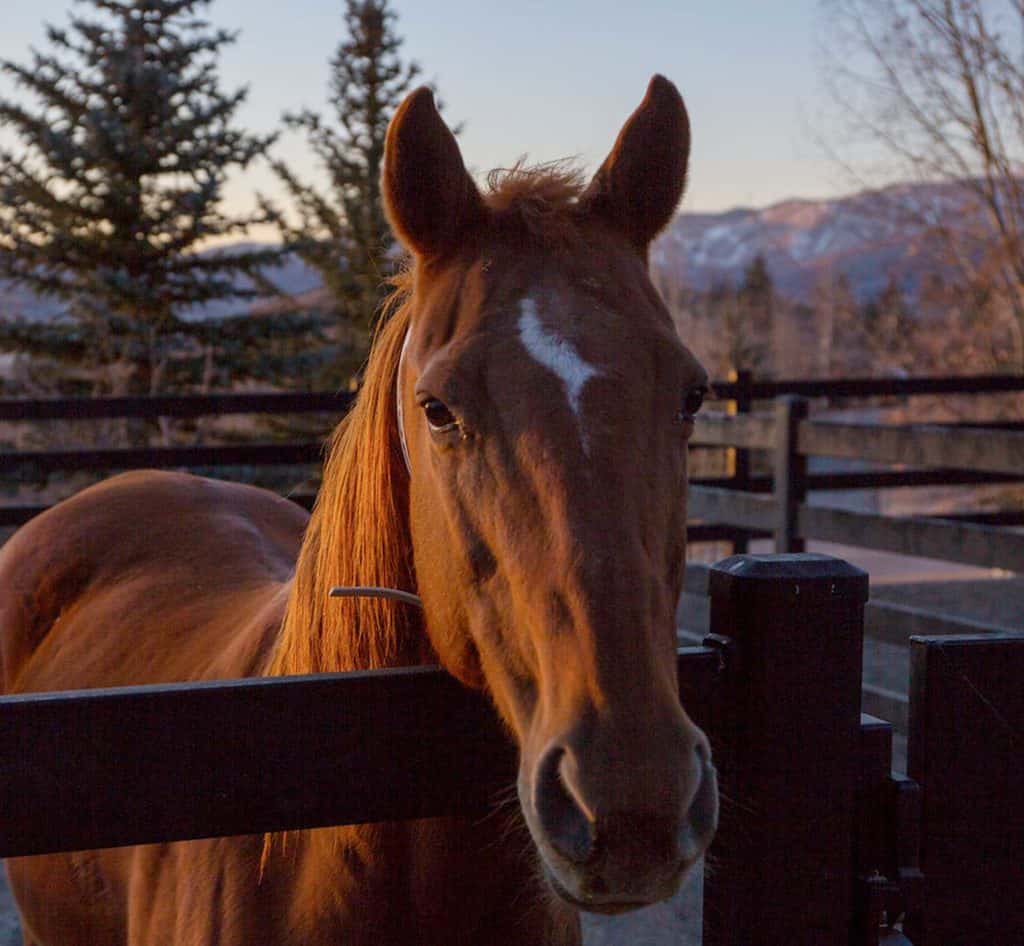Finding the best type of fencing for your horses doesn’t need to feel like training a spirited colt. While there are plenty of options to choose from, only a handful provide the safety, happiness, and long-term reliability you need in a horse fence.
We’re not talking about just any old fence. We’re focusing on the kind of fences that keep your horses safe without any risks of injury from cribbing, wounds from exposed nails, or crashing due to low visibility.
Below, we’ll walk you through everything you need to know to find a fence durable enough to withstand the test of time (and the occasional horseplay).
Choose the Right Fence for Your Horse
When we think about fencing for our hoofed companions, it’s like thinking about a safe playground for kids. Just as kids have their quirks and habits, so do horses, and these can significantly influence the type of fencing you need.
For starters, let’s chat about cribbing. This is a common habit where horses chew on wooden fences, damaging not just the fence but also their health. A fence that discourages this behavior, like one with a smooth, non-wood surface, can be a game-changer.
Then there’s jumping—some horses have the spirit of an Olympic high jumper. It’s about keeping them in and ensuring they don’t hurt themselves while attempting a fence-clearing leap. A fence too low can be an invitation for these adventurous souls, while a fence too high can be intimidating and morale-defeating.
And let’s not forget the general roughhousing that horses often engage in. They might lean, scratch, or even playfully charge at the fence. This means you need something that’s not just tall but also strong and sturdy enough to handle these equine antics.
Your horse fence doesn’t just contain your equestrians. It provides a safe, stress-free environment where they can live, play, rest, and be horses without risk of injury or escape.
 The Best Type of Fencing for Your Horses
The Best Type of Fencing for Your Horses
The best type of fencing for horses considers a few factors, such as:
- Safety
- Quality
- Durability
- Maintenance
- Height
- Cost
Let’s look at some of these aspects in more detail.
Safety Features to Consider
When it comes to fencing for our equine friends, safety isn’t just a feature—it’s the whole ballgame.
- Cribbing: To combat cribbing, opt for non-wood fences such as steel board to deter chewing, protecting both your horse’s health and the fence’s integrity.
- Visibility: High-visibility fencing, with broader rails or vibrant markings, prevents accidental collisions (especially in low light), safeguarding your horses from injuries.
- Hardware: Fences designed without nails, screws, or fasteners eliminate risks of scratches or more severe injuries, ensuring a safer enclosure for your horses.
- Quality: A high-quality fence ensures physical safety and contributes to a horse’s mental well-being, creating a stress-free environment for them to thrive.
 Traditional fencing often uses nails, screws, or other fasteners, which can become loose or protrude, posing severe risks to horses. They might scratch, cut, or impale themselves on these sharp objects. A fence designed without such hazards, using interlocking parts or smooth, solid surfaces, dramatically reduces the risk of such injuries.
Traditional fencing often uses nails, screws, or other fasteners, which can become loose or protrude, posing severe risks to horses. They might scratch, cut, or impale themselves on these sharp objects. A fence designed without such hazards, using interlocking parts or smooth, solid surfaces, dramatically reduces the risk of such injuries.
It’s about creating a secure environment where our horses can roam without worrying about getting snagged or poked.
The absence of these hazardous materials also means less maintenance. You won’t have to constantly check and recheck for loose or protruding hardware, giving you more peace of mind and more time to enjoy the company of your horses.
Durability and Reliability
It doesn’t matter how functional or aesthetically pleasing your horse fence is if it doesn’t stand the test of time. You need a fence you can trust—one that’s going to whether heat, rain, snow, weight, and horseplay. Here are some aspects to consider when opting for a built-to-last horse fence.
Material Matters
When discussing materials, steel board fencing gallops ahead of the pack. Unlike traditional wood that can rot or vinyl that may crack under pressure, steel offers unparalleled strength.

It’s like comparing a rugged, trail-ready horse to a delicate show pony in terms of resilience. Steel board fences stand up to the elements—be it rain, wind, or the occasional horse kick—without wavering.
Constructions Counts
It’s not just what it’s made of but also how it’s put together. Steel board fences are engineered with precision, ensuring every joint and connection is robust and reliable. This means less worry about repairs or weak spots.
Safety Meets Durability
The smooth, rounded edges of steel board fences add an extra layer of safety. There are no splinters or sharp edges that you might find in wood or lower-quality materials. This thoughtful design choice is like choosing a path with no hidden rocks or pitfalls for your horse—safe and secure.
Long-Term Cost Effectiveness
Sure, steel board fences might have a higher upfront cost than some alternatives. But think of it as an investment. Like buying a top-quality bridle that won’t fray or break easily, choosing a durable steel fence means less spending on repairs, replacements, or maintenance in the long run.
Choosing the Right Height for Your Fencing
Regarding horse fencing, height isn’t just a number: it’s crucial to keeping your hoofed friends safe and secure. Think of it like setting the right height for a jump in an equestrian course. Too low, and it’s easily cleared; too high, and it becomes a challenge.
- Preventing Houdini Acts: Some horses are natural-born Houdinis, always looking for an escape opportunity. A fence that’s too low is practically an open invitation for these adventurous spirits to explore the world beyond.
- One Size Doesn’t Fit All: Just like horses come in various shapes and sizes, so should the height of your fences. For smaller breeds or ponies, a fence height of around 4 to 4.5 feet might suffice. But for larger breeds, especially those with a penchant for jumping, you’re looking at a minimum of 5 feet, maybe even higher.
- Bigger Isn’t Always Better: While towering fences might seem like a foolproof solution, they come with their own set of challenges. Extremely high fences can be intimidating and create a sense of confinement for your horses.
- Strength in Height: It’s not just about preventing escapes—a robust, appropriately tall fence also withstands the playful bumps and nudges of horses. Whether they’re leaning, scratching, or even playfully colliding, a sturdy and tall fence stands its ground, reducing the risk of breakages and potential injuries.
Buckley Fence’s Approach to Horse Fencing
 At Buckley Fence, we understand that there’s no compromise when it comes to horse fencing. We prioritize the safety of your animals and your pockets by designing built-to-last steel board fencing meant to stand the test of time.
At Buckley Fence, we understand that there’s no compromise when it comes to horse fencing. We prioritize the safety of your animals and your pockets by designing built-to-last steel board fencing meant to stand the test of time.
- Safety as Priority: Our fences are designed with a safety-first mindset. We ensure features like high visibility, smooth surfaces to discourage cribbing, and the absence of hazardous hardware, creating a haven for your horses.
- Built to Last: Durability is at the heart of Buckley Fence’s products. We use top-grade materials, such as our standout steel board fences, known for their strength and resilience. These fences withstand the elements and equine playfulness, ensuring longevity and reducing long-term maintenance costs.
- Tailored Heights: Recognizing that one size doesn’t fit all in the horse world, our fencing solutions come in various heights. Whether you have a graceful jumper or a curious pony, we have the correct height options to keep them secure and content.
- Unique Features for Horse Owners: Our commitment to innovation and quality sets Buckley Fence apart. Features like our patented rail design and unique installation methods add to the aesthetic appeal and enhance the overall functionality, making them a top choice for discerning horse owners.
Frequently Asked Questions
Q: What types of horse fencing are considered the safest options?
A: The safest types of horse fencing include steel board, vinyl, and pipe fencing. These are all designed to minimize injury risks. Steel board fencing takes the lead with its combination of visibility, durability, and smooth surfaces that prevent cuts or splinters. Pipe fencing offers exceptional strength but ensure all edges are capped and smooth. Vinyl can work well in low-stress areas, though it can shatter in extreme cold. Whatever you choose, avoid barbed wire entirely. The best fence gives your horses clear boundaries they can see and respect without risking their safety when they inevitably test those boundaries.
- Is Steel Board Fence Safe For Horses?
- Is Pipe Fence Safe For Horses?
- Is Wire Fence Safe For Horses?
- Is Vinyl Fence Safe For Horses?
- Is Wood Fence Safe For Horses?
Q: What is the best wood for horse fence if I prefer traditional materials?
A: If you’re set on wood for that classic ranch look, cedar and locust are your best bets for natural rot resistance, while pressure-treated pine offers decent longevity at a more budget-friendly price. Cedar naturally repels insects and moisture, extending its lifespan to 15-20 years with proper maintenance. Whatever wood you choose, seal it properly, use blunt-ended nails or screws, and check regularly for splitting or splintering. That said, today’s steel board options like ours give you that same traditional appearance without the maintenance headaches )the best of both worlds for most horse owners we work with).
Q: Which types of fencing for horses best prevent cribbing and fence damage?
A: To prevent cribbing and fence damage, steel board and pipe fencing are your best options. Unlike wood, which practically invites chewing, steel offers no satisfaction to a determined cribber. Some owners have success with vinyl fencing, but horses can still damage it when determined. Electric fencing can discourage contact, but shouldn’t be your primary containment system. If you already have wood fencing, consider metal cribbing caps or taste deterrents, but these are band-aid solutions at best. In our experience, eliminating the opportunity for cribbing entirely with steel board fencing is the most effective long-term strategy for both your fence’s integrity and your horse’s health.
Q: What makes certain types of horse fencing better than others for different situations?
A: The best fencing depends on your specific situation. For perimeters of large properties, high-tensile wire with visibility strips can be economical. For paddocks and arenas where horses play and exercise, steel board or pipe fencing offers the best combination of safety and durability. For breeding operations with foals, fencing should have smaller gaps to prevent curious youngsters from getting caught. If you’re in an area with predators, taller fencing with smaller gaps near the bottom provides added protection.
Q: How do different horse fence materials compare in terms of maintenance requirements?
A: Wood fencing demands the most attention: annual staining or painting, regular inspection for rot, and replacement of damaged boards. Expect to dedicate at least one weekend per year to maintenance, plus costs for materials. Vinyl requires occasional cleaning but can crack or break when impacted, especially in temperature extremes. Wire fencing needs regular tension checks and can be easily damaged. Steel board fencing, on the other hand, requires just an occasional rinse to keep it looking sharp.
- Wooden Fence vs Steel Board
- Vinyl Fence vs Steel Board
- Wire Fence vs Steel Board
- Pipe Fence vs Steel Board
Invest in the Best Fence for Your Horses
The best horse fencing does more than mark boundaries—it provides safety, happiness, and well-being to your cherished equine companions. Every detail counts, from preventing cribbing and ensuring high visibility to offering robust durability and the perfect height.
At Buckley Fence, we’re dedicated to providing fencing solutions that embody all these essential qualities. Our commitment to safety, quality, and innovation means you’re not just investing in a fence—you’re investing in peace of mind and the future happiness of your horses.
Ready to take the next step towards building a better home for your horses? Request a quote to learn more about how our fencing solutions can be tailored to your specific needs.




 The Best Type of Fencing for Your Horses
The Best Type of Fencing for Your Horses